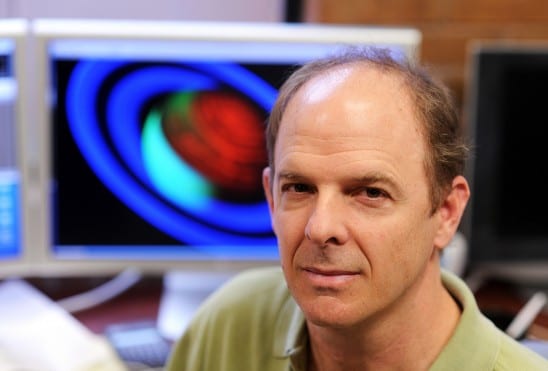Physicist’s Career Launched by Cassini Mission

by Zenaida Kotala
When NASA’s Cassini mission ends on Sept. 15 by plunging into Saturn’s atmosphere, one UCF professor will be reminiscing about the mission that launched his career and the family he’s made throughout the almost 20-year journey.
Physics Professor Josh Colwell began working on the Cassini mission right out of graduate school after his mentor tapped him for the job. Larry Esposito had been selected to lead the team that would be responsible for the Ultraviolet Imaging Spectrograph instrument that has given scientists so much amazing data about Saturn.
Since then, Colwell has continued to work with the team and has gone on to participate in several other NASA missions as well as microgravity flights with commercial space companies. The reason he became a planetary scientist was to dive into a single question: How did the solar system form?
The findings Cassini has produced since arriving at Saturn in 2004 have often surprised and pushed scientists to explain the mysterious rings around the planet, whose origin is still unknown. Saturn still has many secrets about its interior, hidden beneath its thick atmosphere. Even the length of Saturn’s day has been difficult to measure. Cassini’s final orbits may unlock some of these mysteries.
Some results:
- The rings have miniature moonlets within them that have reshaped the rings during Cassini’s mission.
- Titan, Saturn’s largest moon, has huge lakes of natural gas at its poles.
- Enceladus, one of Saturn’s moons, has geysers spewing water vapor and organic chemicals from a subsurface ocean.
The list goes on.
“Cassini has revolutionized our understanding not only of Saturn, its moons and rings, but also Saturn’s place in the history of the solar system,” Colwell said. “And many of those discoveries have been made years after its nominal four-year mission was due to end. After more than 13 years at the ringed planet, it’s going out in a blaze of glory.”
Cassini launched from Kennedy Space Center in 1997 with the goal of exploring Saturn’s rings, the planet, the planet-sized moon Titan, and the other icy moons nearby. There were many mysteries about the Saturn system with only limited data from fly-bys completed by Pioneer 11 and Voyagers 1 and 2 on their way outside the solar system.
Even the spacecraft’s death plunge is likely to produce first-of-its-kind data scientists are hungry for, Colwell said.
The plunge will take the spacecraft through gaps in Saturn’s rings that scientists have never had access to before. The measurements the team hopes to collect from that final dive should help researchers determine the exact mass of those mysterious rings as well as reveal the internal structure of the planet itself.
So why do we care about mass? Scientists are unsure whether the rings are as old as Saturn or much younger. Knowing how much material is in the rings will provide a crucial clue to the ring age. In turn, this will shed light on how the planet formed and the history of the solar system as a whole.
Colwell, an avid Star Trek fan, continues on his mission to unlock the secrets of how our solar system was formed. Cassini has provided valuable clues and the final plunge should provide more data to examine. It could answer some very old questions or spin off more if the data is unexpected.
He’ll be listening to the last radio signals from Cassini from NASA’s Jet Propulsion Laboratory in California, the base of operations for spacecraft maneuvers. He’ll be celebrating and mourning alongside the hundreds of scientists who worked on this mission. It will be bittersweet, Colwell said.
But he wouldn’t change it for the world. The professional growth and friendships over 20 years have helped him become the scientist he is today. And even now, he’s still as eager and energized to find answers to the questions that led him into this field.
“How did the solar system form? How many other planets are out there like our own, and what will we find on all these strange new worlds?” Colwell said.
